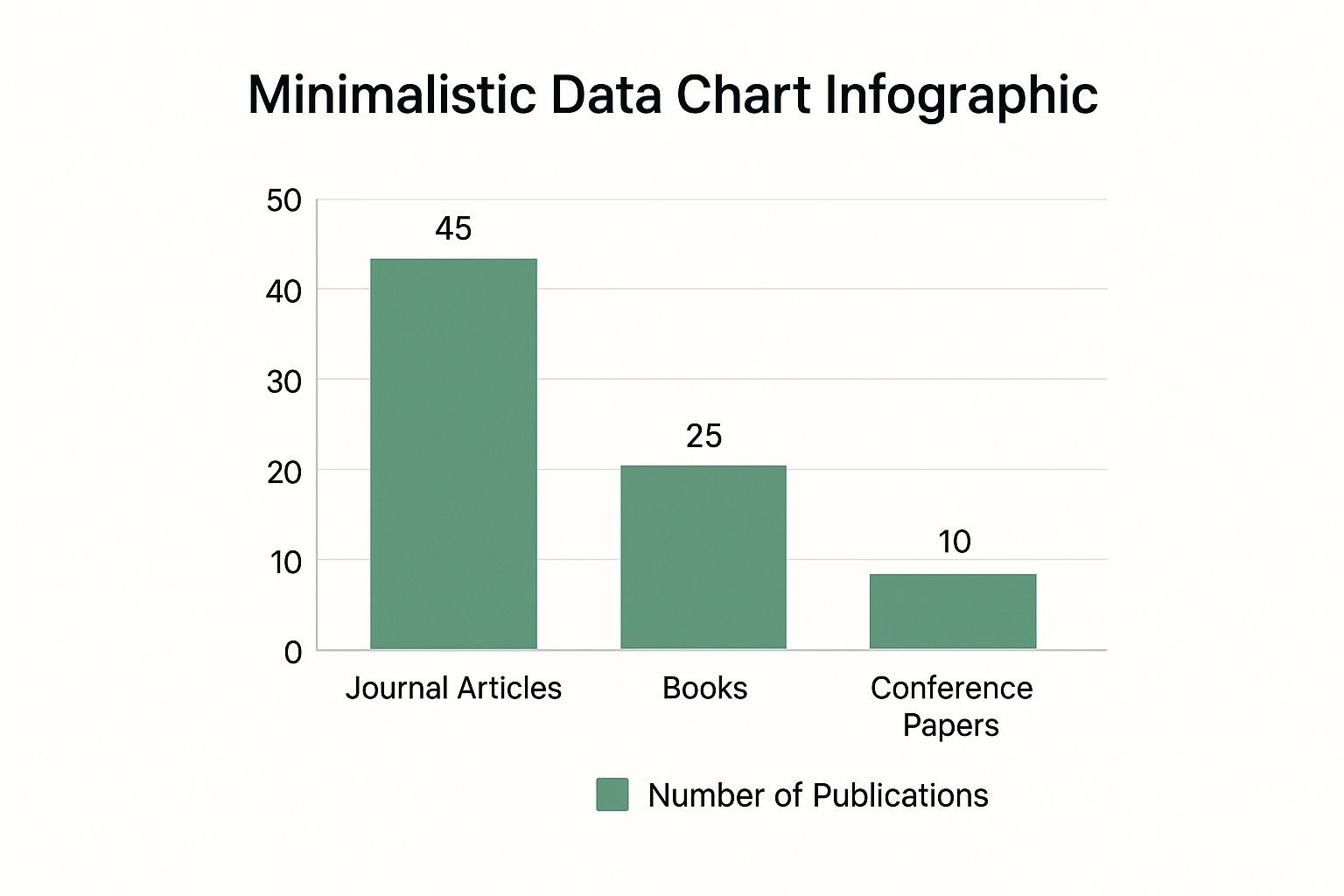
Research Paper Outline Guide: Create Clarity in Your Paper
June 13, 2025
Why Most Research Paper Outlines Fail (And Yours Doesn't Have To)

This screenshot shows Google Scholar. We all know it – that slightly intimidating but incredibly useful tool for researchers. It’s a good visual reminder of just how much information is out there. And that’s exactly why a solid research paper outline is so crucial. Think of it as your compass in this massive digital library, helping you find what you need without getting totally lost.
Let's be honest: most of us have probably treated a research paper outline like a chore. A quick, get-it-done kind of thing. But here’s the problem: that rushed outline often leads to a paper that just doesn't work. The arguments are weak, the flow is all over the place, and the whole thing feels…flat. Trust me, I’ve been there. It’s frustrating and wastes a lot of time.
The Psychology of a Winning Outline
I've talked to journal editors and researchers, and a pattern emerges. Strong papers – the ones that really resonate – aren’t built on rigid templates. They're built on storytelling. Seriously. Think of your outline as the backbone of a good academic story. It’s the roadmap that guides both you and the reader.
Common Pitfalls and How to Avoid Them
One major mistake is creating an outline that just lists topics. Without clear connections between those topics, your paper will feel disjointed. Like a bunch of random paragraphs instead of a cohesive argument. Another issue? Not answering the "so what?" question. Your outline needs to make it absolutely clear why your research matters.
What's new here? Are you challenging an old idea? Filling a gap nobody else has? Offering a fresh approach? Your outline should answer these questions right upfront.
From Checklist to Roadmap: A Strategic Approach
The researchers who really nail it treat outlining as a strategic move. They think carefully about how their argument flows, making sure each section builds on the last. They also anticipate pushback. Think about potential counterarguments and address them in the outline itself. This not only strengthens your argument but shows you’ve really thought things through.
A well-structured outline can also be a lifesaver when dealing with mountains of research material. It helps you filter, focusing on the most relevant sources and weaving that complex information into a clear story. If you’re looking for broader essay tips, this might be helpful: Check out our guide on writing better essays.
A strong outline is the difference between a research paper that shines and one that fades into the background. It's the foundation for a compelling, persuasive piece of work. It's how you transform data and figures into a story that actually connects with your audience.
Building Your Research Foundation Like a Strategic Mastermind

This infographic gives you a visual snapshot of a typical research paper's source distribution: 45 journal articles, 25 books, and 10 conference papers. Notice how journal articles make up the bulk—they're your go-to for current, peer-reviewed info. Books offer that essential background, while conference papers often reveal emerging trends and fresh perspectives, giving your research extra depth. The key takeaway? Gathering sources isn't enough; you need to strategically weave them into a compelling narrative.
Identifying Genuine Gaps: Going Beyond the Obvious
Think of your research paper outline as a map for an intellectual adventure. You wouldn't start a road trip without directions, right? An outline is your guide through the sometimes confusing world of academic research. Before you start writing, spend time finding those real gaps in the existing research. What questions haven't been fully answered? What fresh angles can you offer?
For example, if you're exploring how social media affects political polarization, don't just repeat what's already out there. Look for the subtle differences, explore less-studied groups, or think about how online and offline interactions work together. This strategic thinking not only makes your research more valuable, but also makes your paper stand out. The amount of research out there is exploding – in 2020 alone, about 2.9 million peer-reviewed articles were published globally, with China contributing a whopping 23%. Discover more insights on global research trends. A solid research paper outline is essential to navigate this ever-growing sea of information.
Positioning Your Contribution: Making Your Voice Heard
After you've pinpointed a genuine research gap, you need to strategically position your own contribution. How does your research build on what's already known? What unique insights are you bringing to the discussion? This is where a well-crafted outline becomes your best friend. It helps you map your argument and ensure your findings are presented logically and persuasively.
It's a bit like building a house. The outline is your foundation—it supports the entire project. No solid foundation? The house won't stand. No clear outline? Your research paper will lack focus and impact.
Crafting a Compelling Narrative: Engaging Your Audience
Remember, the best outlines tell a story. They don't just list facts; they weave them into a compelling narrative that grabs the reader's attention. Think carefully about how your argument flows, use smooth transitions between sections, and address potential counterarguments.
From my experience, outlining is more than just organizing – it’s about discovery. As you map your research, you'll often find new connections and ideas you wouldn’t have otherwise seen. It's like putting together a jigsaw puzzle. Each piece is a part of your research, and the outline shows how they all connect. This strategic approach transforms outlining from a chore into a powerful tool for intellectual exploration. It makes sure your research doesn't just contribute to the academic conversation, but shapes it.
Let's talk about different ways to structure your outline. The table below compares a few popular formats, highlighting their strengths and when they're most useful.
Research Paper Outline Formats Comparison
| Format Type | Best For | Complexity Level | Time Investment | Flexibility |
|---|---|---|---|---|
| Traditional Hierarchical | Clearly defined topics and subtopics | Low to Medium | Moderate | Moderate |
| Concept Mapping | Exploring relationships between ideas | Medium to High | Moderate to High | High |
| Chronological | Research based on a time sequence | Low | Low to Moderate | Low |
This table provides a quick overview of how each format helps organize your research. Traditional hierarchical is great for structured topics, concept mapping is ideal for brainstorming and connecting ideas, while chronological is best for research projects based on a timeline. Picking the right format depends on your project and personal preference.
Hooking Readers From Page One: Introduction and Literature Review Magic

This screenshot shows a search on PubMed, a database overflowing with biomedical research. It’s an incredible resource, but it also makes you realize just how important a strong introduction and literature review truly are. In a sea of research, these sections are your lifeline to getting noticed. A well-structured research paper outline is the map, guiding readers through your findings and showing where your work fits in.
Your introduction and literature review are your first impression. But so many researchers fumble this opportunity, diving straight into technical details that can lose a reader before they even get started. This section will cover how to write an introduction that grabs your audience and a literature review that showcases your expertise.
Crafting a Captivating Introduction: The Art of the Hook
The introduction isn't just a summary; it’s your hook. Think of it as the opening scene of a movie – you want to grab the viewer's attention and make them want to see what happens next. A compelling opening could be a real-world story, a thought-provoking question, or a startling statistic. The goal is to set the scene for your research and show why it matters.
Imagine you're telling a story. What’s the core conflict or question your research tackles? Introduce it in a way that sparks curiosity and keeps your reader engaged.
Mastering the Literature Review: Synthesizing, Not Summarizing
A literature review isn't just a summary of other people's work; it's a synthesis. It's about showing how different studies connect to each other and to your own research. This means finding key themes, showing where researchers agree and disagree, and pointing out gaps in what we currently know.
A common trap is presenting the literature review as a bunch of disconnected summaries. Instead, focus on connecting the dots between different studies and showing how they contribute to the overall story of your research. Think of it like weaving a tapestry – each thread is a different study, and your literature review shows how they intertwine to form the big picture.
Practical Strategies for Managing Extensive Literature
Dealing with a ton of research can feel overwhelming. I’ve found that having a systematic approach really helps. Start by organizing your sources by theme or topic. Then, create quick summaries for each study, focusing on the key findings and how they relate to your research. This lets you see the forest for the trees and spot connections you might otherwise miss.
Visual aids can be game-changers. Mind maps or concept maps are fantastic for organizing complex information and seeing the relationships between different studies. This makes the whole process less daunting and helps you see patterns emerge.
Creating Smooth Transitions: Maintaining Reader Engagement
Transitions are crucial for keeping your writing flowing smoothly and keeping your readers hooked. They're the bridges between different sections of your research paper outline, smoothly guiding the reader from one idea to the next. Use clear and concise language that connects each point, creating a seamless narrative.
For instance, phrases like "Building on this research," "However, this perspective overlooks," or "This finding suggests that…" can link different studies and highlight their connections.
Positioning Your Work: The Logical Next Chapter
Finally, your introduction and literature review should clearly position your work as the logical next step in the ongoing academic conversation. How does your research build on what's already out there? What new insights do you bring to the table? Clearly explaining the significance of your research establishes your credibility and shows readers why your work is worth their time. By crafting these opening sections strategically, you not only hook your readers but also set the stage for a compelling and impactful paper. It’s like building a house – a strong foundation is key for everything that follows.
Making Your Methods and Results Shine: The Technical Storytelling Art
This is where the magic happens in your research paper. It's not just about what you discovered, but the journey of how you got there. So many researchers treat these sections like a boring list of what they did and what they found. From my experience, I can tell you that the methods and results sections can actually be pretty interesting—if you think of them as telling a story. Your research paper outline is the roadmap, making sure these crucial sections are both rock-solid and engaging.
Structuring Your Methods For Clarity and Replicability
Think of your methods section like a recipe. Someone reading it should be able to recreate your "dish" (your research study) step-by-step. Clarity is essential. Don’t just list your actions, but explain the why behind your choices. For instance, if you used surveys, explain why they were a better fit than interviews for your specific research question.
Imagine explaining your research process to a colleague over coffee. What details would you share? What questions might they ask? Thinking through these questions while outlining will make your methods section bulletproof.
Presenting Complex Findings in Compelling Ways
Data needs context; it can’t speak for itself. You're the storyteller here. Tables and figures are your best friends – use them to visualize your key findings and make complex data easier to understand. But don’t just throw data onto the page. Guide your reader, pointing out the most important takeaways and linking them back to your original research questions.
Think of each data point as a clue. How does it contribute to the bigger picture? A solid outline helps you present these clues effectively, creating a compelling narrative that leads smoothly into your conclusions.
To help you structure your research methods effectively, take a look at this table:
Research Methods Organization Strategies: A systematic breakdown of how to structure different types of research methodologies in your outline, from quantitative to qualitative approaches.
| Research Type | Key Outline Elements | Common Pitfalls | Organization Tips | Example Structure |
|---|---|---|---|---|
| Quantitative | * Research question * Hypothesis * Variables * Data collection methods * Statistical analysis | * Insufficient sample size * Incorrect statistical tests * Overlooking confounding variables | * Clearly define all variables * Justify the chosen statistical methods * Provide detailed descriptions of data collection procedures | I. Introduction II. Literature Review III. Methods A. Participants B. Materials C. Procedure D. Statistical Analysis IV. Results V. Discussion |
| Qualitative | * Research question * Research design * Data collection methods * Data analysis techniques | * Lack of rigor in data analysis * Subjectivity bias * Difficulty in generalizing findings | * Use established qualitative methods * Triangulate data from multiple sources * Document the data analysis process thoroughly | I. Introduction II. Literature Review III. Methodology A. Research Design B. Participants C. Data Collection D. Data Analysis IV. Findings V. Discussion |
| Mixed Methods | * Research question * Rationale for mixed methods * Research design * Data collection methods * Data analysis techniques * Integration of findings | * Difficulty in integrating different data types * Inconsistent methodology * Lack of clarity in research aims | * Clearly define the role of each method * Develop a detailed integration plan * Ensure compatibility between methods | I. Introduction II. Literature Review III. Research Design A. Justification for Mixed Methods B. Quantitative Strand C. Qualitative Strand D. Integration Strategy IV. Results A. Quantitative Findings B. Qualitative Findings C. Integrated Findings V. Discussion |
This table provides a starting point for organizing your research methods based on the specific type you're using. Remember to adapt and tailor it to fit your individual research project.
Handling Unexpected Results and Maintaining Rigor
Research rarely goes exactly as planned. Unexpected results are bound to pop up. Don’t freak out! These unexpected findings can often be the most intriguing part of your research. Address them directly in your results section, offering possible interpretations and acknowledging any limitations. This shows intellectual honesty and can even spark new research ideas.
A strong outline helps you anticipate these bumps in the road. By carefully thinking through your methodology in advance, you can spot potential weaknesses and develop strategies to deal with them, keeping your work rigorous even when the unexpected happens.
Methodology That's Memorable and Results That Resonate
A clear, well-organized methods section builds trust with your reader, while a compelling presentation of your results strengthens your contribution. Think of it as the peak of your research story. You’ve laid the groundwork, and now you get to reveal your findings in a way that connects with readers.
Use your outline to create a seamless flow from methods to results, keeping your narrative moving and your audience engaged. This is where your technical storytelling skills come into play, transforming dry facts into a memorable and impactful presentation. For example, use analogies or real-world examples to make complicated data more accessible. This not only adds clarity, it also makes your research stick with people. This strategic approach to your methods and results, guided by a well-crafted outline, is what takes your work from a simple report to a powerful piece of scholarship. It lets you present your findings with confidence, knowing you’ve addressed any potential questions and highlighted the true value of your work. Remember, your outline is like having a trusted friend guiding you every step of the way, leading to a more impactful and successful result.
Crafting Discussions That Actually Matter: Beyond Just Restating Results

This screenshot gives you a peek at ResearchGate, a place where researchers share their findings. It really highlights just how much research is out there. This underscores why a powerful discussion is so important. It's where you shine, showing not just what you discovered, but why it matters in the bigger picture. A solid research paper outline helps make sure your discussion isn't just tacked on at the end, but a real contribution.
So, you've got your results, neatly arranged thanks to your carefully planned research paper outline. Now comes the make-or-break moment: the Discussion. This is where you transform cold, hard data into a compelling story that truly resonates.
Interpreting Your Results With Confidence (and Humility)
A good discussion isn't about repeating yourself. It's about interpretation. Think about what your results actually mean in relation to your initial research question. Do they back up existing theories, or challenge them? For instance, let's say you're researching how online learning affects student engagement. Don't just say engagement went down. Explain why you think that happened. Connect your findings to existing research and suggest possible explanations.
Being honest about limitations is also key. No study is perfect. Be open about any weaknesses in your methods or potential biases. This shows intellectual honesty and actually makes your argument stronger. Remember, a good research paper outline should have already flagged these potential limitations, making them easier to discuss.
Avoiding the Repetition Trap: Saying Something New
One common discussion mistake is simply restating the results. Fight the urge to summarize what you've already covered. Instead, zero in on the implications of your findings. What new knowledge have you brought to the table? How do your results shift our understanding?
Think of your discussion as the "so what?" section. You've shown the evidence, now explain its significance. If you're looking to improve your writing in general, check out these tips to polish your skills.
Structuring Your Discussion for Maximum Impact
A well-organized discussion has a logical flow. Begin by briefly summarizing your key findings and connecting them back to your research question. Then, discuss how your results line up with existing research, noting any agreements or disagreements. Finally, consider the implications of your work and suggest future research directions.
Think of your discussion as a bridge between your research and the wider academic world. A well-structured research paper outline acts as the blueprint for this bridge, ensuring a smooth transition.
Ending Strong: Crafting Conclusions That Resonate
Your conclusion shouldn’t feel abrupt; it should be a natural endpoint. Summarize your main points and reinforce the importance of your findings. Don't introduce new information here. Focus on leaving the reader with a clear understanding of your contribution and its lasting impact.
I remember a professor telling me, "Your conclusion is the echo of your introduction." That always resonated with me. It's a reminder that the discussion and conclusion should circle back to your initial questions, creating a satisfying sense of closure. By creating a thoughtful and well-structured discussion, you elevate your research from a simple report to a meaningful contribution, ensuring it stays relevant and impactful long after the reader finishes the last page. A well-developed research paper outline is the foundation of this, allowing your work to truly shine and contribute to the ongoing academic conversation.
Evolving Your Outline Like a Living Document: Advanced Refinement Tactics
This video quickly shows how easy creating a research paper outline can be with simple tools. It's a good reminder that outlining is key, but it doesn't have to be a headache. Think of your outline as a dynamic roadmap for your research. It should be flexible, not rigid.
Embracing the Unexpected: Adapting Your Outline to New Discoveries
Research rarely follows a straight line. I’ve often found my work taking unexpected turns, leading me down paths I never anticipated. Honestly, this is where the magic happens. These unexpected discoveries can bring the most interesting insights. The important thing is to be adaptable and adjust your research paper outline as you go.
For example, my doctoral research on informal economies led me to some fascinating data on waste picker cooperatives. This wasn't even on my radar initially, but it ended up becoming a core part of my dissertation. Your outline is a living document; it should grow and change with your research.
Incorporating Feedback: Refining Your Outline Through Collaboration
Getting feedback is crucial. Whether it comes from your advisor, colleagues, or peer reviewers, those outside perspectives can help you spot weaknesses and build a stronger argument. Even tough criticism can be incredibly helpful.
I presented a paper at a conference once, and the feedback I received was…well, let's just say it was direct. But it made the final version significantly better. Your outline isn’t carved in stone. Use feedback to refine your ideas and make your arguments rock solid. Just like writers need editors, your research needs critical review.
Maintaining Focus While Allowing for Creative Evolution
Being open to new ideas is important, but so is staying focused. Your outline should keep you on track while still giving you space to explore. Think of it as walking a tightrope between structure and flexibility.
One thing I do is regularly check back in with my research question. I make sure every section of my outline directly addresses it. This keeps me grounded but still lets me explore new avenues within my research scope. It's about staying true to your core argument while welcoming those unexpected "aha!" moments.
Using Your Outline as a Diagnostic Tool: Identifying Structural Weaknesses
A good research paper outline can also act like a diagnostic tool. By looking it over, you can often find structural weaknesses in your argument before you write the whole paper. It can be a real game-changer.
I've found that looking at my outline from different angles can be helpful. Try printing it out and physically moving sections around, or using highlighters to mark different themes. This can give you a clearer picture of how your argument flows and help you spot any gaps or inconsistencies. Just like a doctor uses tools to diagnose, your outline helps you catch problems early, saving you time and frustration.
Transforming Your Outline From Static to Dynamic: Real-World Strategies
Refining your outline isn’t a one-and-done deal. It's an ongoing process throughout your entire research journey. The most successful researchers, in my experience, see their outlines not as static plans, but as dynamic thinking tools.
In practice, this might mean several rounds of revisions, adding new research, or changing your approach based on feedback. It's a cycle of continuous improvement that not only refines your writing but also helps you understand your topic better. Your outline becomes a partner in your research, changing and growing along with your understanding. If you're looking for ways to make your writing more compelling, this article might be helpful: Learn how to write more compelling content. It's all about presenting your ideas clearly, engagingly, and persuasively.
Your Research Paper Outline Success Blueprint
This isn't just a summary; it's your personalized action plan for crafting research paper outlines that actually make writing easier. We'll cover helpful tools, smart techniques, and how to recognize when your outline needs a little TLC. Think of this as your personal workshop for building a rock-solid foundation for your research paper.
Essential Tools and Time-Saving Techniques
From trusty word processors like Microsoft Word to dedicated outlining software like Scrivener, choosing the right tools can make all the difference. Personally, I find that mind-mapping tools like XMind are incredibly helpful in the early stages. They let me brainstorm freely and see how ideas connect before I commit to a linear structure. This bird's-eye view is a game-changer, especially for complex projects. And let's not forget the power of cloud-based platforms like Google Docs – perfect for seamless collaboration and access from anywhere.
Time-saving tips? I'm all about the Pomodoro Technique. I set a timer for 25 minutes of focused outlining, then take a 5-minute break. This keeps me sharp and prevents burnout. Trust me, focused bursts are way more effective than trying to power through for hours.
Early Warning Signs: When Your Outline Needs Adjustment
Just like a ship needs course correction, your outline will probably need some adjustments. One telltale sign? You’re constantly deviating from it while writing. This means your initial plan and your research aren't quite aligned. Don’t hesitate to revisit and revise. Your outline is a living document, not set in stone.
Another red flag? You're struggling to connect different sections logically. This often points to a structural issue in your argument. Think of your outline as the skeleton of your paper. If the bones don't fit, the whole structure is shaky.
Practical Checklists and Benchmarks
Having clear benchmarks for each stage can be incredibly helpful. For example, after outlining your literature review, ask yourself: "Does this show a solid grasp of existing research?" and "Does it clearly highlight my unique contribution?" These checkpoints keep you on track and avoid major rewrites later.
Over time, I've developed checklists specific to different research areas. A social science outline might include sections for data collection and ethics, while a humanities outline might emphasize theoretical framework and critical analysis.
Common Challenges and Honest Advice
Outlining isn’t always easy. Finding the sweet spot between detail and flexibility can be tricky. Too much detail makes your outline rigid. Too little, and you're lost at sea. I aim for a balance by focusing on key arguments and supporting points, leaving room for discovery while writing.
Another challenge is managing mountains of information. This is where good note-taking and organization come in. If you're looking to improve your writing, check out this helpful resource on writing compelling content.
Building Confidence and Competence: A Personalized Approach
The best outline is the one that works for you. There's no magic formula. Experiment with different formats and find what suits your research style and writing preferences. The more you do it, the better you'll become at intuitively crafting effective outlines. Trust the process.
A solid outline is an investment in your success. It streamlines the writing process and leads to a stronger, more impactful final paper. Your outline is your guide, your compass, and the foundation for compelling research.
Want some AI help with your writing? Natural Write offers a free and easy way to refine your drafts and make them sound natural and human.


